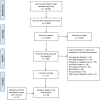Patient-generated health data and electronic health record integration: a scoping review
- PMID: 33758798
- PMCID: PMC7969964
- DOI: 10.1093/jamiaopen/ooaa052
Patient-generated health data and electronic health record integration: a scoping review
Abstract
Objectives: Patient-generated health data (PGHD) are clinically relevant data captured by patients outside of the traditional care setting. Clinical use of PGHD has emerged as an essential issue. This study explored the evidence to determine the extent of and describe the characteristics of PGHD integration into electronic health records (EHRs).
Methods: In August 2019, we conducted a systematic scoping review. We included studies with complete, partial, or in-progress PGHD and EHR integration within a clinical setting. The retrieved articles were screened for eligibility by 2 researchers, and data from eligible articles were abstracted, coded, and analyzed.
Results: A total of 19 studies met inclusion criteria after screening 9463 abstracts. Most of the study designs were pilots and all were published between 2013 and 2019. Types of PGHD were biometric and patient activity (57.9%), questionnaires and surveys (36.8%), and health history (5.3%). Diabetes was the most common patient condition (42.1%) for PGHD collection. Active integration (57.9%) was slightly more common than passive integration (31.6%). We categorized emergent themes into the 3 steps of PGHD flow. Themes emerged concerning resource requirements, data delivery to the EHR, and preferences for review.
Discussion: PGHD integration into EHRs appears to be at an early stage. PGHD have the potential to close health care gaps and support personalized medicine. Efforts are needed to understand how to optimize PGHD integration into EHRs considering resources, standards for EHR delivery, and clinical workflows.
Keywords: consumer health informatics; integration; interoperability; patient-generated health data; precision medicine.
© The Author(s) 2020. Published by Oxford University Press on behalf of the American Medical Informatics Association.
Figures
References
-
- Jackson SE, Chester JD.. Personalised cancer medicine. Int J Cancer 2015; 137 (2): 262–6. - PubMed
-
- Hull S. Patient-generated health data foundation for personalized collaborative care. Comput Inform Nurs 2015; 33 (5): 177–80. - PubMed
-
- Office of the National Coordinator for Health IT [ONC]. Patient-generated health data. 2018. https://www.healthit.gov/topic/scientific-initiatives/patient-generated-... (Accessed January 6, 2020).
Publication types
Grants and funding
LinkOut - more resources
Full Text Sources
Miscellaneous


